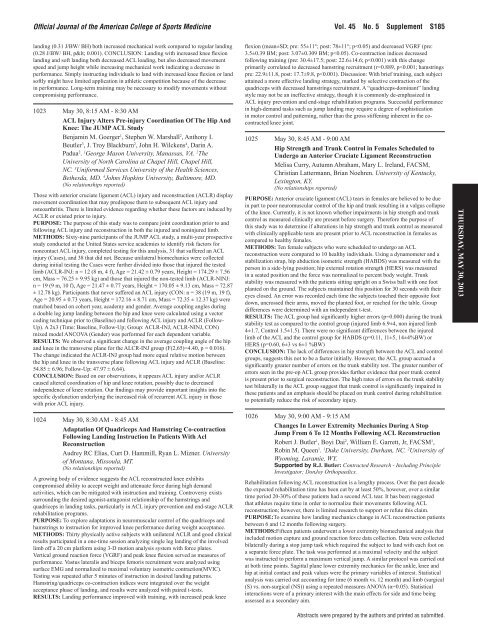Thursday-Abstracts
Thursday-Abstracts
Thursday-Abstracts
You also want an ePaper? Increase the reach of your titles
YUMPU automatically turns print PDFs into web optimized ePapers that Google loves.
Official Journal of the American College of Sports Medicine<br />
landing (0.31 J/BW/ BH) both increased mechanical work compared to regular landing<br />
(0.28 J/BW/ BH, p< 0.001). CONCLUSION: Landing with increased knee flexion<br />
landing and soft landing both decreased ACL loading, but also decreased movement<br />
speed and jump height while increasing mechanical work indicating a decrease in<br />
performance. Simply instructing individuals to land with increased knee flexion or land<br />
softly might have limited application in athletic competition because of the decrease<br />
in performance. Long-term training may be necessary to modify movements without<br />
compromising performance.<br />
1023 May 30, 8:15 AM - 8:30 AM<br />
aCL Injury alters Pre-injury Coordination Of The hip and<br />
Knee: The JuMP aCL study<br />
Benjamin M. Goerger 1 , Stephen W. Marshall 2 , Anthony I.<br />
Beutler 3 , J. Troy Blackburn 2 , John H. Wilckens 4 , Darin A.<br />
Padua 2 . 1 George Mason University, Manassas, VA. 2 The<br />
University of North Carolina at Chapel Hill, Chapel Hill,<br />
NC. 3 Uniformed Services University of the Health Sciences,<br />
Bethesda, MD. 4 Johns Hopkins University, Baltimore, MD.<br />
(No relationships reported)<br />
Those with anterior cruciate ligament (ACL) injury and reconstruction (ACLR) display<br />
movement coordination that may predispose them to subsequent ACL injury and<br />
osteoarthritis. There is limited evidence regarding whether these factors are induced by<br />
ACLR or existed prior to injury.<br />
PurPOsE: The purpose of this study was to compare joint coordination prior to and<br />
following ACL injury and reconstruction in both the injured and noninjured limb.<br />
METhOds: Sixty-nine participants of the JUMP ACL study, a multi-year prospective<br />
study conducted at the United States service academies to identify risk factors for<br />
noncontact ACL injury, completed testing for this analysis, 31 that suffered an ACL<br />
injury (Cases), and 38 that did not. Because unilateral biomechanics were collected<br />
during initial testing the Cases were further divided into those that injured the tested<br />
limb (ACLR-INJ: n = 12 (8 m, 4 f), Age = 21.42 ± 0.79 years, Height = 174.29 ± 7.56<br />
cm, Mass = 76.25 ± 9.95 kg) and those that injured the non-tested limb (ACLR-NINJ:<br />
n = 19 (9 m, 10 f), Age = 21.47 ± 0.77 years, Height = 170.05 ± 9.13 cm, Mass = 72.87<br />
± 12.78 kg). Participants that never suffered an ACL injury (CON: n = 38 (19 m, 19 f),<br />
Age = 20.95 ± 0.73 years, Height = 172.16 ± 8.71 cm, Mass = 72.35 ± 12.37 kg) were<br />
matched based on cohort year, academy and gender. Average coupling angles during<br />
a double leg jump landing between the hip and knee were calculated using a vector<br />
coding technique prior to (Baseline) and following ACL injury and ACLR (Follow-<br />
Up). A 2x3 (Time: Baseline, Follow-Up; Group: ACLR-INJ, ACLR-NINJ, CON)<br />
mixed model ANCOVA (Gender) was performed for each dependent variable.<br />
rEsuLTs: We observed a significant change in the average coupling angle of the hip<br />
and knee in the transverse plane for the ALCR-INJ group (F(2,65)=4.40, p = 0.016).<br />
The change indicated the ACLR-INJ group had more equal relative motion between<br />
the hip and knee in the transverse plane following ACL injury and ACLR (Baseline:<br />
54.85 ± 6.96; Follow-Up: 47.97 ± 6.64).<br />
CONCLusION: Based on our observations, it appears ACL injury and/or ACLR<br />
caused altered coordination of hip and knee rotation, possibly due to decreased<br />
independence of knee rotation. Our findings may provide important insights into the<br />
specific dysfunction underlying the increased risk of recurrent ACL injury in those<br />
with prior ACL injury.<br />
1024 May 30, 8:30 AM - 8:45 AM<br />
adaptation Of Quadriceps and hamstring Co-contraction<br />
Following Landing Instruction In Patients With acl<br />
reconstruction<br />
Audrey RC Elias, Curt D. Hammill, Ryan L. Mizner. University<br />
of Montana, Missoula, MT.<br />
(No relationships reported)<br />
A growing body of evidence suggests the ACL reconstructed knee exhibits<br />
compromised ability to accept weight and attenuate force during high demand<br />
activities, which can be mitigated with instruction and training. Controversy exists<br />
surrounding the desired agonist-antagonist relationship of the hamstrings and<br />
quadriceps in landing tasks, particularly in ACL injury prevention and end-stage ACLR<br />
rehabilitation programs.<br />
PurPOsE: To explore adaptations in neuromuscular control of the quadriceps and<br />
hamstrings to instruction for improved knee performance during weight acceptance.<br />
METhOds: Thirty physically active subjects with unilateral ACLR and good clinical<br />
results participated in a one-time session analyzing single leg landing of the involved<br />
limb off a 20 cm platform using 3-D motion analysis system with force plates.<br />
Vertical ground reaction force (VGRF) and peak knee flexion served as measures of<br />
performance. Vastus lateralis and biceps femoris recruitment were analyzed using<br />
surface EMG and normalized to maximal voluntary isometric contraction(MVIC).<br />
Testing was repeated after 5 minutes of instruction in desired landing patterns.<br />
Hamstring/quadriceps co-contraction indices were integrated over the weight<br />
acceptance phase of landing, and results were analyzed with paired t-tests.<br />
rEsuLTs: Landing performance improved with training, with increased peak knee<br />
Vol. 45 No. 5 Supplement S185<br />
flexion (mean±SD; pre: 55±11°; post: 78±11°; p


